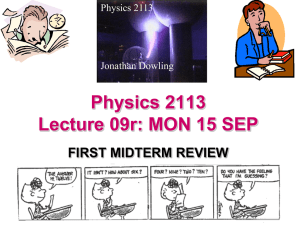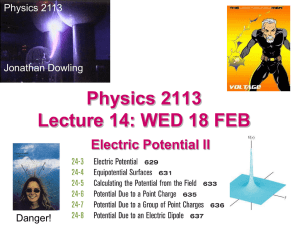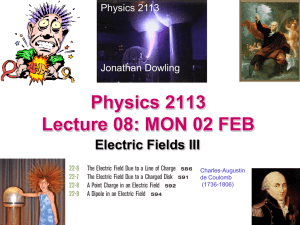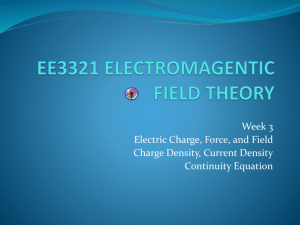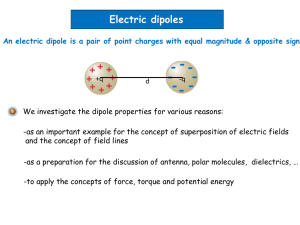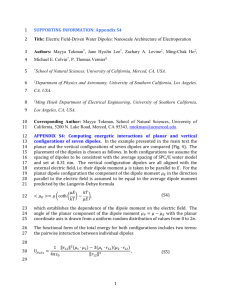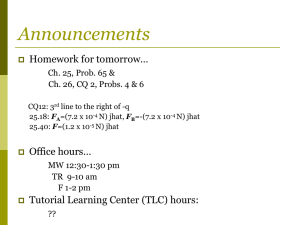Electric Fields - Galileo and Einstein
advertisement
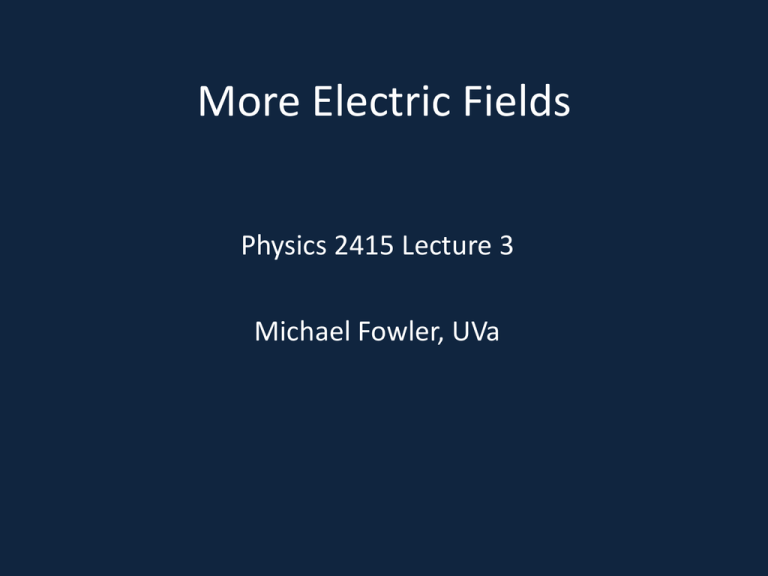
More Electric Fields Physics 2415 Lecture 3 Michael Fowler, UVa Today’s Topics • • • • Continuous charge distributions: line of charge Visualizing the field: lines of force Electron moving in a field Electric dipoles Superposition • The total electric force on a charge Q3 from two charges Q1, Q2 is the vector sum of the forces from the charges found separately. Q1 Q3 F23 kQ 2 Q 3 rˆ23 2 r23 F to tal o n Q 3 Q2 F13 kQ1Q 3 rˆ13 2 r13 Sounds trivial—but superposition isn’t true for nuclear forces! Field from Two Equal Charges • Two charges Q are placed on the y-axis, equal distances d from the origin up and down. What is the electric field at a point P on the x-axis, and where is its maximum value? y-axis Q r d x x-axis E to tal P d E upper charge Q kQ rˆ r 2 • Anywhere on the axis, the field is along the axis, and has value E 2 kQ r 2 cos 2 kQ x r 3 2 kQ x x d 2 2 3/ 2 . Field from a Uniform Line of Charge • What’s the electric field at a • q point P distance R from a very long line of charge, say C/m? • Take the wire along the z-axis in 3D Cartesian coordinates,we’ll find the field at a point P, distance R from the wire, in the (x,y) plane. • The strategy is to find the field zd E from a bit dz of the wire, then do an integral over the whole wire. z-axis R sec P R dE from charge in d R tan dz R tan O Field from a Uniform Line of Charge • The strategy is to find the field d E • q z from a bit dz of the wire, then do an integral over the whole wire. k d R tan k d kdq k dz dE r 2 r 2 R sec 2 2 R • For an infinite wire, the net field must be directly away from the wire, so multiply by co s and integrate over all z : E k R /2 / 2 cos d 2k R z-axis dz r R sec P R dE from charge in d R tan z R tan O Electric Field from a Plane of Charge • It’s worth drawing the field • a lines to emphasize that the electric field from a uniformly charged plane is directly outward from the plane. • Charge density: Coulombs/m2 E 2 k 2 0 Field for Two Oppositely Charged Planes • a E + 0 = Superpose the field lines from the negatively charged plate on the parallel positively charged one, and you’ll see the total field is double in the space between the plates, but exactly zero outside the plates. Motion of an Electron Between Two Oppositely Charged Plates • Two uniformly charged plates • a with equal but opposite charge generate a uniform electric field between them, except near the edges. • An electron entering this region will feel a constant downward force, and act E exactly like a projectile under 2 0 2 0 0 gravity, with downward acceleration eE/m. Field of Two Equal Charges off the Axis • Close to one of the • a charges, its own field dominates. On the axis between them, the field is along the axis. • To find the field elsewhere, we must add the two field vectors, and so can trace lines of force. Field Lines for Two Equal Charges • The lines are more crowded where the field is stronger, but at the central point there is zero field strength— the vertical lines go into that point, the horizontal lines come out. Field on Axis from Two Opposite Charges • This is a dipole: the analysis is just like the two equal charges case: y-axis Q r d x-axis P R d E upper charge E to tal -Q kQ rˆ r • Anywhere on the axis, the field is downward, and has value E 2 kQ r 2 sin 2 kQ d r 3 2 kQ d R 2 d 2 3/ 2 R 2 kQ d R 3 2 The Dipole Field • Notice that the field lines near a charge are dominated by that charge, and that they cross the axis at right angles. • d More Electric Field Lines… • For nonequal charges, and more general charge distributions, check out these applets! • http://www.its.caltech.edu/~phys1/java/phys 1/EField/EField.html • http://www.phy.ntnu.edu.tw/ntnujava/index. php?topic=740.0 Molecular Dipoles • Many molecules, for example H2O, are actually electric dipoles—all that’s necessary is that the center of negative charge isn’t the same point as the center of positive charge. • A small dipole will line up in an external electric field just as a compass needle (which is a magnetic dipole) lines up in the Earth’s magnetic field. Torque on a Dipole in an Electric Field • For a dipole +Q, -Q separated by a distance as shown, the dipole moment is defined as a vector length p Q and direction along the line from –Q to +Q. • The torque 2 Q E / 2 sin pE sin , p E. • d +Q F Q E p F Q E -Q Potential Energy of Dipole in Electric Field • Taking the dipole initially perpendicular to the field, if• d it turns to angle the electric forces have pushed the charges distances / 2 co s in their direction of action, so have done work 2 Q E / 2 cos p E • Therefore the potential energy of the dipole is: U p E . F Q E +Q F Q E p -Q / 2 co s Potential Energy of Dipole in Electric Field: Torque Approach 2 Q E / 2 sin pE sin , • d +Q p E. p • A torque does work dW d on turning through angle d , so the total work on going from 90 to 0 is: W 0 90 d pE 0 90 -Q sin d pE cos 0 p E U p E . Why is this negative? Remember when an object falls, the gravitational force does positive work on it, and it’s losing that amount of potential energy. Microwaving Water Dipoles • Recall the water molecule has the Mickey Mouse shape, the H’s share their electrons, so there’s extra positive charge in those ears, a dipole moment of strength p = 6.2 x 10-30 C.m. • This tends to orient the molecule with the electric field. • In a microwave, the strong electric field changes direction billions of times per second—the molecules constantly adjust, bumping into each other, creating heat. • Ice doesn’t absorb the energy so well. Why?
